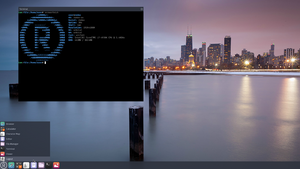Software:Redox (operating system)
 | |
 Redox running Ion shell in Orbital windowing system | |
| Developer | Jeremy Soller, Redox Developers[1] |
|---|---|
| Written in | Rust, assembly |
| OS family | Unix-like |
| Working state | Current |
| Source model | Free software |
| Initial release | 20 April 2015 |
| |Final preview|Latest preview}} | 0.8.0 / 24 November 2022 |
| Marketing target | Desktop, workstation, server |
| Available in | English |
| Package manager | pkgutils |
| Platforms | x86-64; ARM64 in development[2] |
| Kernel type | Microkernel |
| Userland | Custom |
| Influenced by | POSIX[3] |
| Default user interface | Command-line, Orbital |
| License | MIT |
Redox is a Unix-like microkernel operating system written in the programming language Rust, which has a focus on safety, stability, and performance.[4][5][6] Redox aims to be secure, usable, and free. Redox is inspired by prior kernels and operating systems, such as SeL4, MINIX, Plan 9, and BSD. It is free and open-source software distributed under an MIT License.
Redox gets its name from the reduction-oxidation reactions in chemistry; one redox reaction is the corrosion of iron, also called rust.
Design
The Redox operating system is designed to be secure.[4] This is reflected in two design decisions:
- Using the programming language Rust for implementation
- Using a microkernel design, similar to MINIX
Components
Redox provides packages (memory allocator, file system, display manager, core utilities, etc.) that together make up a functional operating system. Redox relies on an ecosystem of software written in Rust by members of the project.
- Redox kernel – derives from the concept of microkernels, with inspiration from MINIX
- Ralloc – memory allocator
- TFS file system – inspired by the ZFS file system
- Ion shell – the underlying library for shells and command execution in Redox, and the default shell
- pkgutils – package manager
- Orbital windowing system – display and window manager, sets up the orbital: scheme, manages the display, and handles requests for window creation, redraws, and event polling
- relibc – C standard library
Command-line applications
Redox supports command-line interface (CLI) programs, including:
- Sodium – vi-like editor that provides syntax highlighting
Graphical applications
Redox supports graphical user interface (GUI) programs, including:
- NetSurf – a lightweight web browser which uses its own layout engine
- Calculator – a software calculator which provides functions similar to the Windows Calculator program
- Editor – simple text editor, similar to Microsoft Notepad
- File Browser – a file manager that displays icons, names, sizes, and details for files; uses the launcher command to open files when they are clicked
- Image Viewer – Image viewer for simple file types
- Pixelcannon – 3D renderer, can be used to benchmark the Orbital desktop
- Orbterm – ANSI type terminal emulator
History
Redox was created by Jeremy Soller and was first published on 20 April 2015 on GitHub.[7] As of July 2021, the Redox repository had a total of 79 contributors.[8]
References
- ↑ "Redox Contributors". https://gitlab.redox-os.org/redox-os/redox/graphs/master.
- ↑ "Porting Redox to ARM (AArch64)". 6 August 2018. https://medium.com/@wizofe/rsoc-porting-redox-to-arm-aarch64-0x02-c566ee22f377.
- ↑ "What is Redox?". https://doc.redox-os.org/book/ch01-02-what-is-redox.html.
- ↑ 4.0 4.1 "Redox - Your Next(Gen) OS - Redox - Your Next(Gen) OS". https://www.redox-os.org/.
- ↑ Weisinger, Dick (4 May 2016). "Operating Systems: Rust Redox – An Next-Generation Attempt to Plug Linux OS Gaps". Formtek, Inc.. http://formtek.com/blog/operating-systems-rust-redox-an-next-generation-attempt-to-plug-linux-os-gaps/.
- ↑ . Yegulalp, Serdar (21 March 2016). "Rust's Redox OS could show Linux a few new tricks". InfoWorld (San Francisco: IDG Communications, Inc.). http://www.infoworld.com/article/3046100/open-source-tools/rusts-redox-os-could-show-linux-a-few-new-tricks.html.
- ↑ Soller, Jeremy (jackpot51) (20 April 2015). "Initial commit of Rustboot-based OS". GitHub, Inc.. https://github.com/redox-os/redox/commit/0edea108a1d8112b3aa4e8ae7b3d8d41c5d0ed85.
- ↑ "Redox Repository". https://github.com/redox-os/redox.
External links
 |

